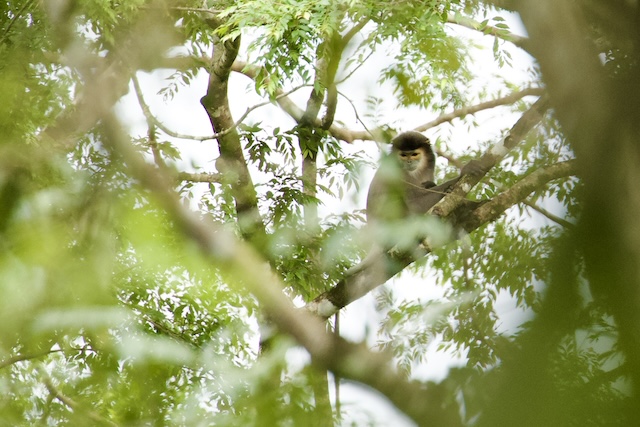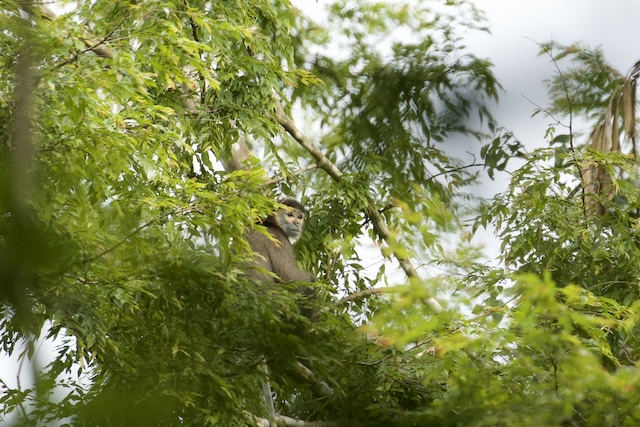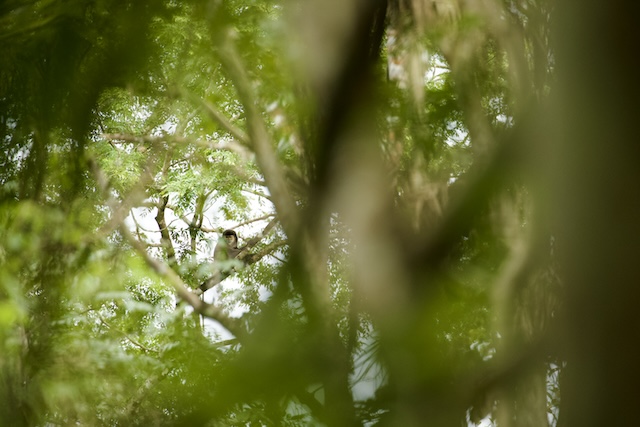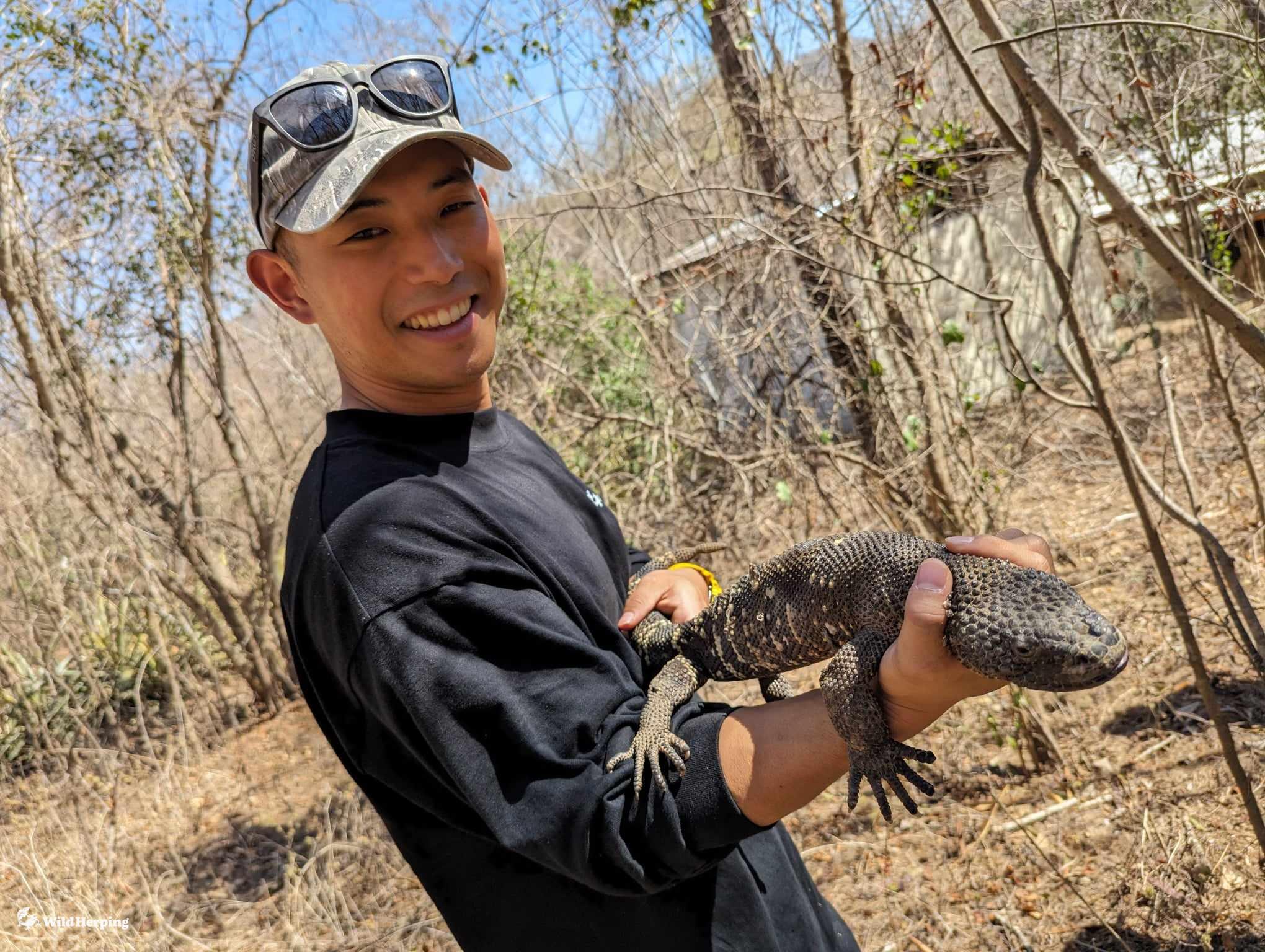
Exploring the dense jungles of Vietnam, we set out on a mission to encounter the mesmerizing Black-Shanked Douc Langur (scientific name: Pygathrix nigripes). With its stunning blue face and distinctive black legs, this rare primate captivates anyone lucky enough to spot it. Found only in the lush rainforests of Vietnam, Cambodia, and Laos, this unique species embodies the enchanting diversity of Southeast Asia’s tropical wildlife. Here, we’ll dive into the langur’s characteristics, habitat, diet, social behavior, and more to offer an insightful guide for anyone who hopes to catch a glimpse of these incredible creatures.
Distinctive Features of the Black-Shanked Douc Langur
True to its name, the Black-Shanked Douc Langur’s legs are black, while its body ranges in shades from deep gray to black, with lighter patches on its chest and back. Most striking is its blue face with large, expressive eyes, ringed with white fur around the mouth and eyelids. This distinctive color combination isn’t found in any other primate, making it stand out in the rainforest’s green expanse. The Black-Shanked Douc Langur’s warm gaze and graceful demeanor further enhance its allure, although this same beauty has made it vulnerable to illegal poaching.

Habitat: Where to Find Black-Shanked Douc Langurs
Black-Shanked Douc Langurs inhabit the tropical rainforests of Vietnam, Cambodia, and Laos, particularly thriving in mountainous areas at elevations between 500 and 1,200 meters. They are adapted to an arboreal (tree-based) lifestyle, skillfully navigating the forest canopy and spending much of their lives away from the forest floor. During the day, they move together through the trees, finding food and resting high above ground to avoid predators. Their natural habitat is not only a source of food and shelter but also a sanctuary for their social groups, protecting them from the threats that lurk in the lower levels of the forest.
Diet and Feeding Habits
The Black-Shanked Douc Langur has a plant-based diet, feeding mainly on leaves, fruits, flowers, and seeds. This herbivorous lifestyle keeps them in the forest canopy, away from ground-dwelling competitors. In addition to being skilled at finding food in the treetops, these langurs play a critical role in seed dispersal, which helps support forest regeneration. Their unique digestive system has four stomach chambers, similar to ruminants, allowing them to effectively break down fibrous leaves. This specialized diet shapes not only their large, rounded bellies but also their role in the rainforest ecosystem, where they contribute to plant diversity.
Social Behavior and Intelligence
Highly social creatures, Black-Shanked Douc Langurs typically live in groups of five to ten members. They maintain close-knit bonds and communicate through vocalizations and gestures, creating a rich social dynamic within their groups. In each group, younger members often play the role of food gatherers and lookout scouts, while adults care for young langurs and maintain group harmony. Such organized social behavior strengthens group cohesion, promoting safety and well-being for each member.

Tips for Spotting Black-Shanked Douc Langurs
For those hoping to spot these rare primates, it’s helpful to observe their feeding habits. Because they spend long hours eating foliage in the cool mornings and evenings, these times offer the best chances of a sighting. When you spot one, others are likely nearby, as they move together in groups. They tend to avoid areas frequented by other primate species like macaques, so keep this in mind when planning your search. With patience and a bit of luck, you may witness one of the most mesmerizing sights in Southeast Asia’s jungles.

Conservation Status: An Urgent Call for Protection
The Black-Shanked Douc Langur is critically endangered, largely due to habitat destruction and illegal poaching. Deforestation for agriculture and illegal logging has reduced their forest habitats significantly. The langur’s unique appearance also makes it a target for pet trafficking, leading to a sharp decline in population. As social animals, they are particularly vulnerable when isolated; without the support of a group, they struggle to find food and often die shortly after capture due to improper care and diet.
Conservation efforts are essential for their survival. Partnerships with local communities to promote sustainable ecotourism have proven effective, supporting the region’s biodiversity while providing vital income for conservation initiatives. Several organizations are now working with local communities to preserve the langur’s habitat and raise awareness about this species’ precarious status.
The Role of Ecotourism in Conservation
Sustainable ecotourism plays a significant role in preserving species like the Black-Shanked Douc Langur. Ecotourism not only generates funding for conservation but also educates visitors about the importance of protecting these unique creatures. Trained local guides provide tourists with insights into the langur’s lifestyle, social habits, and habitat, fostering a deeper appreciation for conservation efforts. Visitors leave not only with memorable experiences but also with a heightened awareness of how responsible tourism can benefit ecosystems and the creatures within them.
Protecting Our Future
Protecting the Black-Shanked Douc Langur means preserving the rich biodiversity of Southeast Asia’s tropical rainforests. By supporting ecotourism and conservation initiatives, each of us can contribute to ensuring the future of this extraordinary species. Conservation efforts benefit not only the langurs but also countless other species that depend on the rainforest. Together, we can make a positive impact, safeguarding these beautiful creatures and their homes for future generations.
In Conclusion
Finding and photographing the elusive Black-Shanked Douc Langur in the depths of the jungle was a once-in-a-lifetime experience. After five days of trekking, I was finally able to capture the beauty of this gentle creature in its natural environment. For anyone with an adventurous spirit, a trek to find the Black-Shanked Douc Langur promises an unforgettable journey filled with awe and discovery.










